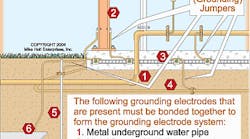All Code references are based on the 2005 NEC. The grounding and bonding requirements in this column apply to solidly grounded systems that operate at not more than 600V, such as 120/240V, 120/208V, and 277/480V.
NASCAR racers treat their tires with a care approaching reverence. Even the most powerful engines are useless if the tires don't properly meet the track. And large grounding conductors are useless if your grounding electrode system doesn't properly meet the earth. In the first case, you start by selecting the right tires. In the second, you start by selecting the right electrodes.
Electrodes you can use. A grounding electrode system consists of grounding electrodes that are bonded together. When used in a grounding electrode system, they're earthing electrodes and they make up an earthing system. You can use the following electrodes for such an earthing system. If more than one is present, they must be bonded together (Fig. 1.):
-
Underground metal water pipe [250.52(A)(1)]
-
Metal frame of the structure [250.52(A)(2)]
-
Concrete-encased grounding electrode [250.52(A)(3)]
-
Ground ring [250.52(A)(4)]
-
Ground rod [250.52(A)(5)]
-
Grounding plates [250.52(A)(6)]
If none of these electrodes is available, you must install one or more of the following:
-
Ground ring [250.52(A)(4)]
-
Ground rod [250.52(A)(5)]
-
Grounding plates [250.52(A)(6)]
-
Metal underground systems [250.52(A)(7)]
Electrode requirements. Each type of electrode has a specific set of requirements that you must follow.
Underground metal water pipe. When in direct contact with the earth for 10 feet or more, an underground metal water pipe can serve as a grounding electrode (Fig. 2). If this pipe is interrupted by something, such as a water meter, you must make it electrically continuous with a bonding jumper sized per 250.66. If you use interior metal water piping to interconnect electrodes that are part of the grounding electrode system, you can generally do so only within 5 feet of where the piping enters the structure. See the exception in 250.52(A)(1).
Metal frame of the structure. If you use the structural frame as an electrode, it must be of substantial cross-sectional area. Bond it to an electrode as defined in 250.52(A)(1), (3), or (4) unless:
-
10 feet or more of a single structural metal member is in direct contact with the earth or encased in concrete that is in direct contact with the earth.
-
The authority having jurisdiction (AHJ) approves some other means.
Concrete-encased grounding electrode (Ufer ground). Where the supply to a structure consists of multiple services or feeders as permitted by 225.30 and 230.2, you must use the same electrode for grounding (earthing) enclosures and equipment in or on that structure. The most practical method for meeting this requirement is to ground (earth) each of the disconnecting means to a common concrete-encased grounding electrode [250.52(A)(3)].
Electrically conductive steel reinforcing bars at least ½ inch in diameter or 4 AWG copper conductor can serve as a grounding electrode if the bar or conductor is at least 20 feet long (conductive length), encased in at least 2 inches of concrete, and within and near the bottom of a foundation or footer that is in direct contact with earth.
The steel rebar need not be one continuous length. You can conductively join multiple sections with the usual steel tie wires to create a 20-foot, concrete-encased grounding electrode (Fig. 3).
Ground ring. To qualify as a grounding electrode, a ground ring must contain at least 20 feet of bare copper conductor that is at least 2 AWG. It must encircle the structure and be in direct contact with earth at least 30 inches below the surface [250.53(F)].
Ground rod. A ground rod must have at least 8 feet of contact lengthwise with the soil, which means it can't be less than 8 feet long [250.53(G)]. The upper end of the ground rod must be at grade (or underground) unless you protect the grounding electrode conductor attachment against physical damage per 250.10. See 250.52(A)(5) and 250.53(A) for details. If you encounter rock bottom when driving the rod, you can drive it at an angle not to exceed 45° from vertical, or bury it at least 30 inches deep.
Unlisted ground rods must be at least ⅝ inch in diameter. Listed ground rods must be at least ½ inch in diameter. The diameter doesn't affect resistance to ground (earth). See IEEE-142, Table 13 for reference. Larger diameters increase mechanical strength (and service in the face of corrosion).
Ground plate. You can use a buried iron (or steel) plate at least ¼ inch thick — or a nonferrous (copper) metal plate at least 0.06 inch thick — with an exposed surface area at least 2 square feet. It must be at least 30 inches below grade [250.52(A)(6)].
Metal underground systems. You can use such things as piping systems, underground tanks, or underground metal well casings that aren't effectively bonded to a metal water pipe.
All electrodes. Where practical, embed electrodes below permanent moisture level. Make sure they're free from nonconductive coatings (e.g., paint or enamel) [250.12 and 250.53(G)]. If more than one grounding electrode exists at a structure, separate them by at least 6 feet. [250.53(B)]. Use fittings listed for direct soil burial or concrete encasement if the grounding electrode attachment fitting is underground or directly buried in concrete [250.68(A) Ex. 1 and 250.70].
Electrodes unsuitable for grounding. You can't use either of the following as electrodes:
-
Underground metal gas piping, which present a risk of explosion (Fig. 4 on page 60).
-
Aluminum electrodes, which are at risk of electrically-induced corrosion of dissimilar metals [250.52(B)].
The jumpers that bond. If your grounding electrode system is within 18 inches of earth, use copper to bond the grounding electrodes together [250.64(A)]. Size it per 250.66. Securely fasten the bonding jumper to the surface on which it's carried, and protect it from physical damage [250.64(B)].
Terminate grounding electrode bonding jumpers to the grounding electrode by exothermic welding, listed lugs, listed pressure connectors, listed clamps, or other listed means. When the termination is encased in concrete or buried, use termination fittings that are listed and identified for this purpose (250.70).
The bonding connection to the interior metal water piping system (required by 250.104), must not depend on water meters, filtering devices, or similar equipment that might be removed. Install a bonding jumper around removable equipment to assist in clearing and removing dangerous voltage from a ground fault to the metal water pipe [250.53(D)(1), 250.68(B) and 250.104] (Fig. 5 above). You must supplement the underground metal water pipe grounding electrode (if present) with one of the acceptable electrodes discussed earlier.
Supplementary vs. supplemental. Don't confuse the requirements for supplementary electrodes (250.54) with those for supplemental electrodes, such as the underground metal water pipe [250.53(D)(2)].
A supplementary electrode establishes an additional electrical connection to the earth but isn't part of the main electrical connection to the earth. An example of a supplementary electrode is a ground rod installed next to a machine tool. Technically, it serves no purpose, but some equipment manufacturers who are unaware of grounding theory require them anyway.
You can't use a supplementary electrode as an effective ground-fault current path for electrical equipment as required by 250.4(A)(5) and 250.4(B)(4). You don't have to ground the supplementary electrode to the grounding electrode system of the structure, and you don't have to size the grounding (earthing) conductor for it per 250.66.
If the supplementary electrode is a ground rod, it doesn't have to comply with the 25 ohm requirement of 250.56.
Lightning protection. If you use a grounding electrode for a lightning protection system, you can't use it as a grounding electrode for the structure grounding electrode (earthing) system required by 250.50.
The purpose of a lightning protection system installed per NFPA 780 is to protect the structure from lightning damage. The concern that bonding the lightning protection system to the building grounding system may create a path for lightning into the electrical wiring or equipment within the structure doesn't justify keeping the two systems separate; separation creates a dangerous potential between them. You must bond your lightning protection electrode system to the structure grounding electrode (earthing) system (250.106).
Now you understand the types of grounding electrodes you can use — or in some cases, must use — and some specific requirements that apply. You've learned important requirements about the bonding jumpers used with these electrodes. And you won't inadvertently confuse supplemental electrodes with supplementary electrodes — you know an example of the former is a water pipe and an example of the latter is a machine electrode and these have different requirements.
With this newfound knowledge you can keep your grounding systems “on track.”









